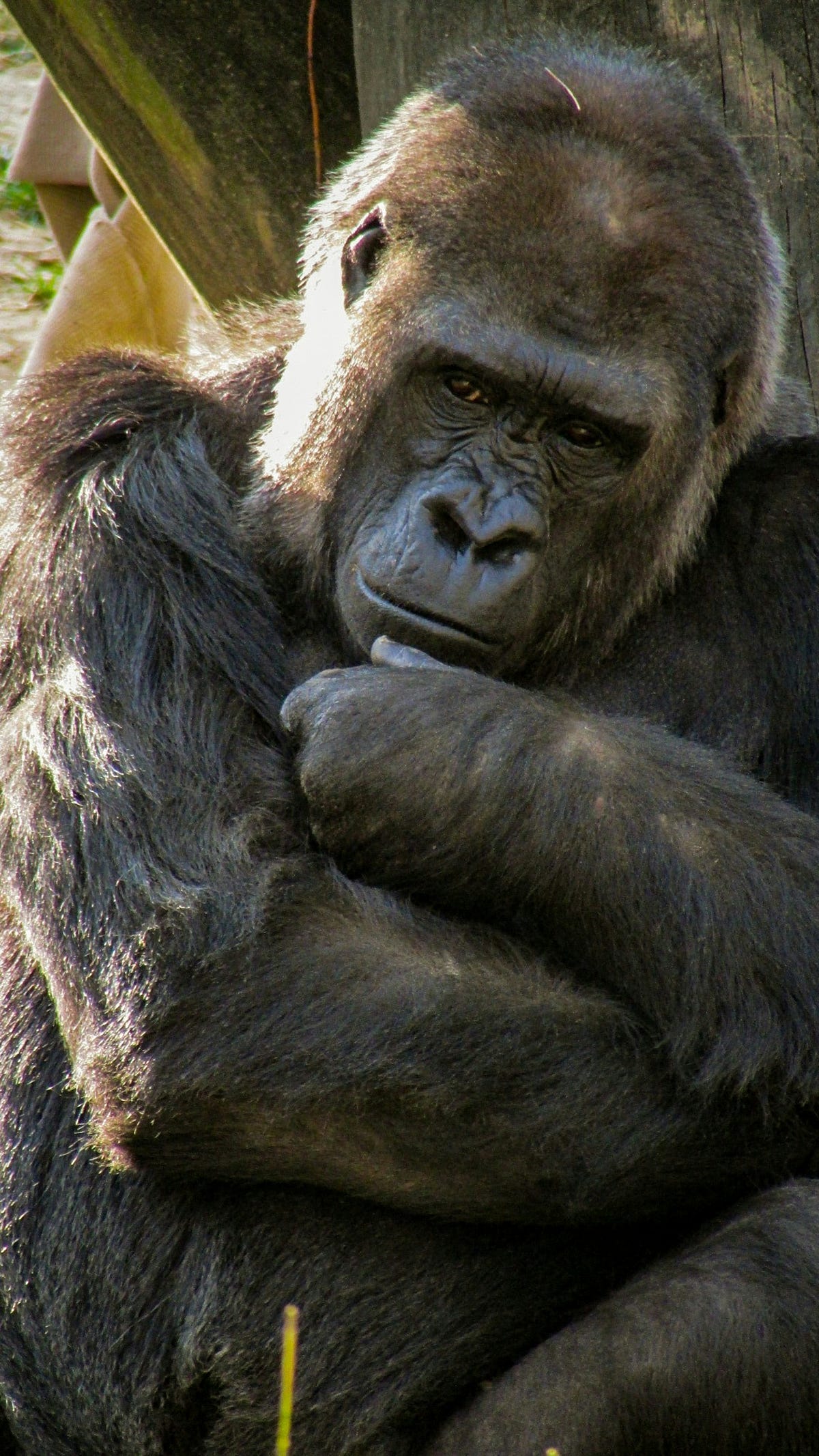
Gorillas can flaunt their power by controlling their harems.
Harems are social groups where a single silverback controls the sexual reproduction of other females. No other male gorilla would engage sexually with the females in the alpha’s harem.
But a silverback’s rule is not always a sure bet. Up-and-coming males occasionally challenge their leadership. Tarzan challenged the alpha silverback's leadership when he grew up in the jungle.
Eventually, silverback reigns are bound to fall. And when they fall, the new alpha does the most heinous thing — it kills the infants it didn’t participate in creating. Infanticide is common in gorillas, who are one step away from our closest relatives, chimpanzees.
Chimps also commit infanticide using the same principles.
Jared Diamond called us the third chimpanzee. The difference between our genome and theirs is 1.6%. A biased focus on the genes rather than other factors can lead scientists to affix reasons to fit the Procrustean bed of a gene-centred view of evolution. It’s not always in the genes.
The prevalent argument is that infanticide benefits the alpha male because it is certain he wouldn’t invest in raising a kid that isn’t his. Infanticide will tip females back into the reproductive cycle, since lactation is a natural form of contraception. The younger, the infant, the better and easier for the dominant male.
The male, however, ensures little harm to the female it hopes to mate with. So, where does that leave the female gorillas?
While it benefits the males, it dismisses the expensive investments of the female gorillas and chimpanzees. It is not adaptive for female chimps to have their kids killed by other alpha males. Natural Selection has little say on this matter.
How, then, did the third chimpanzees, the humans, overcome this problem?
I am coaxed to believe the reason is our women.
Female mate choice is one formidable answer
As an extension of sexual selection, female mate choice is a powerful force. We can start with the most extreme evidence.
Consider that in humans, infanticide is often committed by females and not males. Mothers, step-mothers, and grandmothers are the ones who are notorious for ending children’s lives. It has even been documented in our close relatives, forming plausible evidence to show the transition from chimps to humans. Not the fathers. That’s how powerful female choice can be. Why?
Maybe they didn’t like the choice of the father. The father could have forced his way on her. The constant reminder of a face you don’t like can drive you to end the child’s life.
Men, on the other hand, hardly commit this act. Numerous fathers get into relationships with mothers, but don’t kill the children.
The reason could be well explained by female mate choice. Females grew more attracted to males who would hardly force their way on them.
Among chimps, gorillas, and even baboons, the males would showcase their sharp canines whenever the females showed signs of defiance. It would put her in check. Male dominance undermines female sexual autonomy among these apes.
Males also have elongated canines, which are honed by the lower jaw premolar. These are constantly sharpened using the canine honing mechanism. A sharp and large canine can inflict untold harm to the females.
Other features that they use to their advantage are their large size. Male gorillas, chimpanzees, and baboons are significantly larger than the females.
But what if humans changed when female sexual autonomy persisted and began giving favourable options for the less coercive, brutal males?
Humans are larger than chimpanzees, but the disparity between the male and female sizes is not as large as that of the gorilla. Undoubtedly, men still have a size advantage over women in fighting, but the difference is not significant despite humans being larger than chimps.
Secondly, human canines are so small as to be worthy of comparison with our relatives. Textbook explanations for the changes in our dental features are tied to diet.
Humans began tenderizing their kill with the harnessing of fire. There should therefore be no need for the sharp canines. But this reason does not explain the changes in the dental features of the late ancestors who had not begun changing their dietary preferences.
Ardipithecus ramidus already had a tremendous change in its canine features, lacking the canine honing complex, before it could engage the side motions of its jaws to feed on the complex plant material. Other primates are also not strict carnivores as to warrant the sharp canines.
On the flip side, when humans smile, there are hardly differences in the canine features of the males and the females.
The reason could be that females began preferring less coercive males.
Additionally, females don’t tend to like extremely muscular males. The bodybuilders don’t feature in the top pick of most women today, and in the past. This extreme masculinization happens out of male-male competition.

In contrast, females prefer the masculine men in the gray-area zone. A complex mix of strong build and gentle behaviour gains precedence over a burst of sinew above and below the waist.
The hypothesis of male deweaponization gives a better explanation for the size reduction between females and males, the preference for the moderately muscular men and the reduction in canine size besides other preferences including an elaboration of sexual ornaments in men such as the penis size. These features lack adequate explanation from the theory of Natural Selection.
The deweaponized male would progressively reduce their participation in infanticide. The reason could be tied to female sexual autonomy, preferring gentler males. The term gentlemen could have originated from this preferred slew of traits. Male investments would therefore be fully at the mercy of females, who could then perform infanticide if they so wish.
Organismal Selection
Organisms tend to avoid annihilation. That is the first feature to note about the unpopular hypothesis of Organismal Selection. The other is that organisms would seek mergers to avoid annihilation. A merger is best identified when the role of one entity serves another and vice versa. It could explain some features seen in our ancestors and humans.
For a long time, females have been under the hostile rule of males. The gorillas have exercised this power and continue to do so, as do the chimpanzees and baboons. The mergers sought by these apes are the kind that one would be certain would not lead to annihilation.
Thus, male silverback gorillas heavily guard their harems. The role of the male is to protect the females. The female’s role, through compliance, serves the male. They act as a single organism.
According to the theory of Organismal Selection, an organism is best seen when subjected to an imminent, credible threat. It tends to resist the threat in a manner that preserves its existence. Usually, it’s to preserve the existing merger.
For the females, it will comply with the threats they receive from the dominant male to avoid annihilation. For the alpha male, it will fight off any male that threatens his dominant position. For the beta males, they will attempt to fight the alpha to increase the chances of making mergers with the females.
For the males that commit infanticide, it would preserve their mergers with the females while ascertaining oneself of their bloodline progeny. Production of babies demands a certain form of certainty from the parent and, in particular, the father. This instinct persists to date, with the billion-dollar revenues generated from paternity tests.
These are attempts to form and preserve mergers.
One explanation that didn’t sit right with me was the behaviour of the females. The litmus test for the physical existence of an organism is resistance. Female apes don’t show this outrightly. They would rather comply. Indeed, it is a way to preserve oneself, but the resistance is much more subtle. It was expressed through mate choice.
Females began preferring the males who would rather be less hostile and more caring. Their preferences would be muscular but not to extreme proportions. Their canines would be less protruding. They would be less inclined to kill children. Infanticide by males would be frowned upon. These are the ways female primates resisted the credible threats from our male ancestors. Thus, the theory of Organismal Selection still stands by its tests of confirming the existence of an organism.
These are also the reasons bowerbirds evolved to include bowers in their mating rituals. Or how the ducks changed their vaginal anatomy to reduce the successes of male ducks who tended to practice forced copulation. Today, we know that females would rather take their lives or the lives of their unborn children than live their lives with men they abhor.
Female sexual autonomy is how females resist the credible threats forced on them by their male counterparts. This resistance is so strong as to transcend generations, cross various species lines, and change body morphologies.
The theory of Organismal Selection highlights the importance of female choice. Organisms get to choose who they create mergers with. In contrast, Natural Selection undermines the importance of choice.
What I’m trying to say is…
Female mate choice is a highly plausible reason males don’t tend to commit infanticide in humans.
According to the theory of Organismal Selection, it is a means through which females have continued to resist male coercion and violence. This evolution has progressed to the point where females are extremely picky, choosing qualities they would want from a man but not necessarily live with them. Thus, sperm banks were formed. It has been the women all along.
Since the choice and autonomy significantly rest with the female sex, they are the ones who can decide which baby they will keep and which they won’t. That is power; power acknowledged through the theory of Organismal Selection.
Initially, men coerced women.
They complied.
Then, females resisted.
Men complied.
That’s why we hardly have human male infanticide.
Indeed, here is some truth to Beyonce’s song when she asks:
Who runs the world?
This song inspired some of the lines used in this article. Source — YouTube




https://orken73.substack.com/p/addiction-philosophy-of-freedom-in
Ukhtomsky and Edelman, Tononi